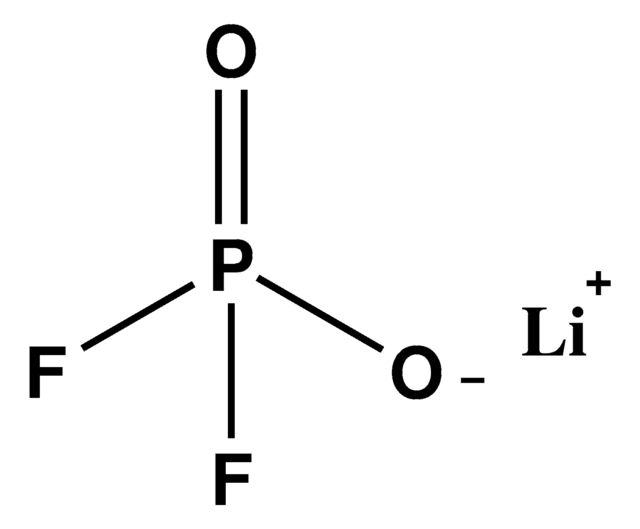Kluczowe dokumenty
935832
Lithium bis(fluorosulfonyl)imide
99.9% trace metals basis, battery grade
Synonim(y):
"Imidodisulfuryl fluoride, lithium salt", Ionel LF 101, LiFSI, Lithium bis(fluorosulfonyl)amide, Lithium bis(fluorosulfonyl)imido, Lithium imidodisulfuryl fluoride
Wybierz wielkość
489,00 zł
Wybierz wielkość
About This Item
489,00 zł
Polecane produkty
klasa czystości
battery grade
Poziom jakości
opis
Application: Battery manufacturing
Próba
99.9% trace metals basis
Formularz
powder
charakterystyka ekologicznej alternatywy
Design for Energy Efficiency
Learn more about the Principles of Green Chemistry.
sustainability
Greener Alternative Product
mp
140 °C
ślady anionów
chloride (Cl-): ≤5 ppm
sulfate (SO42-): ≤10 ppm
ślady kationów
K: ≤10 ppm
Na: ≤5 ppm
Zastosowanie
battery manufacturing
kategoria ekologicznej alternatywy
ciąg SMILES
FS([N-]S(F)(=O)=O)(=O)=O.[Li+]
InChI
1S/F2NO4S2.Li/c1-8(4,5)3-9(2,6)7;/q-1;+1
Klucz InChI
VDVLPSWVDYJFRW-UHFFFAOYSA-N
Szukasz podobnych produktów? Odwiedź Przewodnik dotyczący porównywania produktów
Opis ogólny
Zastosowanie
produkt powiązany
Hasło ostrzegawcze
Danger
Zwroty wskazujące rodzaj zagrożenia
Zwroty wskazujące środki ostrożności
Klasyfikacja zagrożeń
Acute Tox. 4 Oral - Eye Dam. 1 - Muta. 2 - Skin Irrit. 2
Kod klasy składowania
11 - Combustible Solids
Klasa zagrożenia wodnego (WGK)
WGK 3
Temperatura zapłonu (°F)
Not applicable
Temperatura zapłonu (°C)
Not applicable
Wybierz jedną z najnowszych wersji:
Certyfikaty analizy (CoA)
Nie widzisz odpowiedniej wersji?
Jeśli potrzebujesz konkretnej wersji, możesz wyszukać konkretny certyfikat według numeru partii lub serii.
Masz już ten produkt?
Dokumenty związane z niedawno zakupionymi produktami zostały zamieszczone w Bibliotece dokumentów.
Nasz zespół naukowców ma doświadczenie we wszystkich obszarach badań, w tym w naukach przyrodniczych, materiałoznawstwie, syntezie chemicznej, chromatografii, analityce i wielu innych dziedzinach.
Skontaktuj się z zespołem ds. pomocy technicznej









